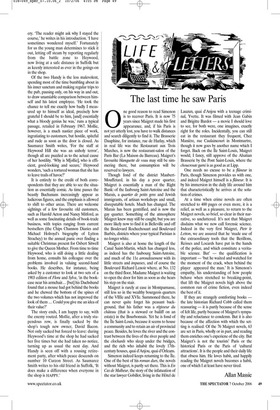The battle of the books
Selina Hastings
A SPY IN THE BOOKSHOP: LETTERS BETWEEN HEYWOOD HILL AND JOHN SAUMAREZ SMITH, 1966-1974 edited by John Saumarez Smith Frances Lincoln, £12.99, pp. 176, ISBN 0711226989 ✆ £10.39 (plus £2.45 p&p) 0870 429 6655 By now Heywood Hill’s bookshop in Curzon Street must be almost as famous as 84 Charing Cross Road. Opened in 1936, the shop first became familiar through the lively accounts of Nancy Mitford, who worked there from 1942-45. Then came A Bookseller’s War, the correspondence between Heywood Hill, away in the army, and his wife, Anne, left in charge of the shop; and most recently, in 2004, The Bookshop at 10 Curzon Street, the letters written to each other by Nancy and Heywood. Now, published in the same attractive format, comes A Spy in the Bookshop, which might be described as reports from the front line in an ongoing shop war which had begun exactly as the other war ended.
The background is this: in 1945 Heywood Hill, a gentle, bookish man, had taken on a new partner, Handasyde (‘Handy’) Buchanan, a seemingly convenient arrangement as Handy’s wife, Mollie, was already working in the shop in charge of accounts. But Handy turned out to be a curmudgeonly character, possessing all ‘the concealed malice of the underdog’, as Evelyn Waugh so memorably put it; before long, and with the able assistance of the poisonous Mollie, he had effortlessly succeeded in alienating staff and customers alike. By the time Heywood sold the shop in 1964 he had been so bloodied and bruised by the Buchanans that instead of staying on in a consultative capacity, as he had planned, he was obliged to sever all communication with Curzon Street, not even daring to have his hair cut, as was his long-established custom, at Trumper’s, the barber’s next door.
It is at this point that a new character comes on stage. John Saumarez Smith, just down from Cambridge, is hired by Handy as an assistant. Saumarez Smith already has a black mark against him as he is related by marriage to the Hills, and from his very first day the Buchanans regard him as the enemy. Nothing he does is right, and between them the malign pair set out to make his life a mis ery. ‘The reader might ask why I stayed the course,’ he writes in his introduction. ‘I have sometimes wondered myself.’ Fortunately for us the young man determines to stick it out, letting off steam by reporting regularly from the battle zone to Heywood, now living at a safe distance in Suffolk but as keenly interested as ever in the goings-on in the shop.
Of the two Handy is the less malevolent, spending most of the time bumbling about in his inner sanctum and making regular trips to the pub, pausing only, on his way in and out, to draw unamiable comparison between himself and his latest employee. ‘He took the chance to tell me exactly how badly I measured up to himself as ideal, precisely how grateful I should be to him, [and] essentially what a bloody genius he was,’ runs a typical passage, retailed in February 1967. Mollie, however, is a much nastier piece of work, ingratiating to customers, but hostile, spiteful and rude as soon as the door is closed. As Saumarez Smith writes, ‘For the staff at Heywood Hill she was an unholy terror’, though all are puzzled as to the actual cause of her hostility. ‘Why is M[ollie], who is efficient, good-looking and secure,’ Heywood wonders, ‘such a tortured woman that she has to leave trails of havoc?’ It is entirely to the credit of both correspondents that they are able to see the situation as essentially comic. As time passes the beastly Buchanans increasingly appear as ludicrous figures, and the emphasis is allowed to shift to other areas. There are welcome sightings of a few favourite old customers, such as Harold Acton and Nancy Mitford, as well as some fascinating details of book-trade business, with topics ranging from current bestsellers (the Chips Channon Diaries and Michael Holroyd’s biography of Lytton Strachey) to the annual panic over finding a suitable Christmas present for Osbert Sitwell to give the Queen Mother. From time to time Heywood, who is still doing a little dealing from home, consults his colleague over the problems involved in valuing second-hand books. He describes, for instance, being asked by a customer to look at two sets of a 1903 edition of Flora and Sylva, ‘in the bookcase near his armchair... [but] his Dachshund found that a mouse had got behind the books and he chewed the bottom of the spines of the two volumes which has not improved the look of them ... Could you give me an idea of their value?’ The story ends, I am happy to say, with the enemy routed. Mollie, after a truly stupendous row, is finally sacked by the shop’s tough new owner, David Bacon. Not only sacked but forced to leave: during Heywood’s time at the shop he had sacked her five times but she had taken no notice, turning up as usual the next day. And Handy is seen off with a rousing retirement party, after which peace descends on number 10 Curzon Street. As Saumarez Smith writes to his old friend in Suffolk, ‘It does make a difference when everyone in the shop is HAPPY.’



















































































 Previous page
Previous page